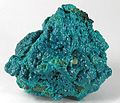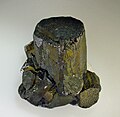Following is a list of minerals that serve as copper ores in the copper mining process: [1]
| Image | Name | Formula | % Copper when pure |
|---|---|---|---|
 | Chalcopyrite | CuFeS2 | 34.5 |
 | Chalcocite | Cu2S | 79.8 |
 | Covellite | CuS | 66.5 |
 | Bornite | 2Cu2S•CuS·FeS | 63.3 |
 | Tetrahedrite | Cu3 SbS3 + x(Fe,Zn)6Sb2S9 | 32–45 |
 | Digenite | Cu9S5 | 78.1 |
 | Malachite | CuCO3•Cu(OH)2 | 57.7 |
 | Azurite | 2CuCO3•Cu(OH)2 | 55.1 |
 | Cuprite | Cu2O | 88.1 |
 | Tenorite | CuO | 79.7 |
 | Chrysocolla | (Cu,Al)2H2Si2O5(OH)4•n(H2O) | 37.9 |
 | Tennantite | Cu12As4S13 | 51.6 |
 | Dioptase | CuSiO2(OH)2 | 45.3 |
 | Enargite | Cu3AsS4 | 48.4 |